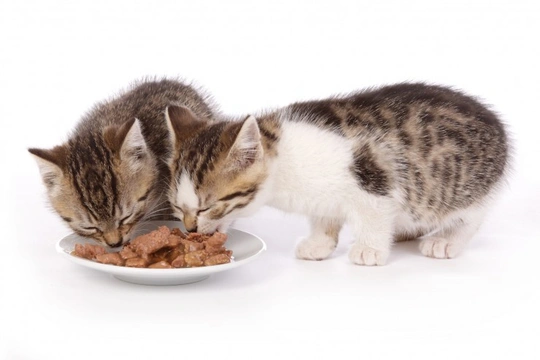
If you are planning to breed from your cat or have already done so and the time for weani
If you are planning to breed from your cat or have already done so and the time for weaning is approaching, it is important to manage the whole of the weaning process carefully in order to ensure that it all goes smoothly, and that your kittens are not weaned too soon or are reluctant about eating solid food when they go off to their new homes.
In the wild, kittens tend to continue to feed from their queen for longer than cats bred in a domestic environment, whilst also eating solid food as well. Often, wild kittens do not become fully weaned and begin to fend for themselves until their queen falls pregnant with her next litter, but as within the domestic home, your cat will not be bred again right away and also, your kittens will need to be weaned to be sold, this is something that you will have to manage!
In this article, we will look at when and how to wean kittens in order to ensure a seamless, effective transition from milk to solid food by the time that your kittens are old enough to go off to their new homes. Read on to learn more.
When should kittens be weaned?
Weaning should be undertaken gradually, and at a pace that is suitable to the kittens and not their owner! Kittens should not go on to their new homes until they are twelve weeks old, and trying to rush the process so that your kittens can be sold sooner is strongly discouraged.
Kittens will generally start showing an interest in what their mother is eating when they reach about four weeks old, and your queen may either allow her kittens to do this, or push them out of the way, so ensure that there is plenty of food available for all of your cats! Kittens will take to soft and scented food much more willingly than to dry kibble, so feed a specific kitten food aimed at very young kittens, and if necessary, mix it with water to make it even sloppier in texture and so, not such a great change from the texture of milk.
Between the ages of around four and five weeks old, your kittens will generally start showing an interest in such food, while still getting the majority of their nutrition from their queen’s milk.
Between around five and six weeks of age, your kittens will likely start to eat more food and less milk, and at this point you will generally be able to offer food without mixing it with water, and start introducing small pieces of dry kitten food, which will appeal to your kittens as it is crunchy.
Between six and eight weeks of age, the kittens will progressively eat more food and less milk, to the point that by the time they are eight weeks old, they may well be eating solid food only, and the queen’s milk will begin to dry up.
It is important to remember that even if your kittens are eating completely on their own by eight weeks of age, they should not be removed from their queen until they are twelve weeks old, as this final month with their mother helps to teach them important life lessons about interactions with other cats, and also, allows them to learn from observation.
What should weaning kittens be fed?
There are a huge range of different types of kitten food on the market aimed at cats under one year of age, but when you very first start weaning your kittens, you might want to consider picking a food specifically designed to meet the needs of very young kittens, such as Royal Canin’s Babycat food. At the start of the weaning process, the food should be near to liquid in texture and fragrant and appealing, and as your kittens get larger and more keen to eat solid food, you can begin to phase in more solid wet food and small kitten kibble.
Each time you make a change or addition to what you offer to your kittens, it is important to do this gradually and not suddenly stop offering one food and replace it with another, as small kittens have sensitive stomachs, and need time to get used to different types of food at their own pace, to avoid stomach upsets.
It is also a good idea to gently warm up your kitten’s first solid food offerings to make it more appealing to them, and also, to ensure that their food later on is given at room temperature or warm, and not cold from the fridge.
Don’t leave uneaten wet food down to the point that it becomes unpalatable or dry, and never try to speed up the weaning process by trying to wean your kittens earlier or attempting to force them to eat.
Finally, when your kittens do go to their new home, you should tell the buyers what the kittens are used to eating and if possible, give them a few days’ supply, and ensure that they understand that any changes they may wish to make to the kitten’s diet should be undertaken gradually.



